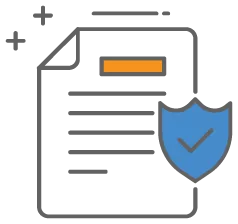
The Capitol One chargeback process is similar to how most issuing banks and credit card networks conduct their chargeback process. Typically this process involves three parties: the customer, the merchant, and the issuing bank.
Capitol One is one of the most common credit card issuers today. That’s why it’s important to know how the Capital One chargeback process works and how it differs from other issuers. Follow along to find out not only how your business can fight a Capital One chargeback, but how you can prevent Capital One transaction disputes altogether!
How Does a Capital One Credit Card Dispute Work?
Generally, the chargeback process rests squarely on the shoulders of card networks and issuers. When merchants challenge a chargeback dispute, the issuing bank reviews the details and decides with whom to side.
After a cardholder files a dispute, Capital One temporarily withdraws the funds from the merchant’s account. The merchant can either accept or dispute the chargeback. If the merchant disputes the chargeback, they must provide evidence disproving the cardholder’s claim. If Capital One accepts the merchant’s representation, it returns the funds to the merchant’s account.[1]. Capital One.“Dispute a credit charge”. Accessed November 10, 2022. Capital One also explains its decision and provides a copy of the merchant’s evidence to the cardholder via a letter.
If either one of the parties is dissatisfied with the outcome of the claim, it may go to arbitration. Arbitration is governed by credit card networks. Arbitration requires the losing party to pay the arbitration fee.
What You’ll Need to Handle a Capital One Chargeback
As a merchant, you’ll likely handle a high volume of chargebacks from Capital One simply because it is one of the largest credit card issuers. To submit evidence that is compelling enough to win, make sure you have the following on hand.

Chargeback data reports
This document provides all the relevant information about the chargeback, including customer information and the reasoning. Reviewing this data carefully can help you make a decision about whether or not to dispute the chargeback. In some cases, it may be clear that you have a strong case and should proceed with disputing it. In other cases, the data may show that disputing the chargeback is unlikely to be successful.

Detailed information on all transactions
Supporting documents will help you resolve a chargeback dispute in your favor. Send invoices, receipts, order confirmations, or shipping tracking information to the issuing bank that’s handling the chargeback. It’s always best to keep detailed information for every customer in case a chargeback occurs in the future. By keeping records, you’ll be able to streamline the process of disputing chargebacks.

Copy of your terms and conditions
A terms and conditions statement that a customer must agree to before purchasing from you, indicates the customer agreed to your return policy. You may even take a screenshot of your terms and conditions at the checkout page to further prove a customer must read it to continue to purchase from your business.

Payment authentication reports
All businesses should have the proper measures in place to authenticate a transaction before they authorize it. For eCommerce merchants, these features are on your payment gateway and involve fraud filters to decline fraudulent transactions. You can download these reports from your payment gateway proving you have taken all the steps to prevent fraud.
How to Dispute a Chargeback at Capital One
To protect your business, you should dispute a chargeback if it’s illegitimate. When a customer files a chargeback, your acquirer will notify you to file a dispute and give you the timeframe for doing so. Collect any customer data and transaction details that can be used as evidence. When you submit relevant evidence, be sure to include a rebuttal letter that defends your case and explains that the chargeback is invalid.
It’s worth noting that you may still receive a chargeback fee even if you submit accurate information on time and the dispute is in your favor. That said, disputing a chargeback is well within your rights and often the best route to take for your business, especially when you consider that 32% of merchants that dispute a chargeback show a successful outcome.[2]. Chargebacks 911. “2021 Chargeback Field Report”. Accessed on November 10, 2022..
Tips for Dealing with Capital One Disputes and Customer Service
Most of the responsibility falls on the merchant when chargebacks happen. The process can be lengthy, and because it involves many parties, it can be a bit complicated. Establishing the following best practices will assist you with dealing with Capital One disputes:
- If you are still communicating with the customer, keep it professional and friendly. You may be able to resolve the dispute in your favor if you can keep open communication with them.
- Pay close attention to deadlines. Not submitting evidence automatically disqualifies you from having your side of the case heard.
- Don’t hold back on any details surrounding the dispute. Providing all the relevant information like messages, tracking, or return policy benefits you.
- Consider partnering with a chargeback protection service. Not only will they assist with managing chargebacks coming your way but also fight chargebacks on your behalf.
Chargebacks due to fraud are often the most expensive to fight. However, by following your intuition and trusting in your training, you’ll be able to spot fraudsters and block them from doing business with you in the future.
Final Thoughts on Managing Capital One Chargebacks
Although the Capital One chargeback process can be a bit time-consuming, if the information in your case is accurate and you follow Capital One’s rules and regulations, you can see positive outcomes. Identifying the primary cause of the chargebacks, recording and tracking disputes accurately, and ensuring robust anti-fraud defenses can go a long way in guarding against chargebacks in the future.
Capital One Chargeback: FAQ
How long do your customers have to dispute a charge at Capital One?
It’s always best to report and/or dispute a fraudulent charge as soon as possible. However, Capital One gives customers up to 60 days to file a claim after a charge has appeared on the credit card statement.
How long is the Capital One dispute processing time?
The dispute process can take anywhere between 30-90 days due to the number of claims Capitol One must review, the response time of the merchant and customer, and the complexity of the case.
What is a Capital One purchase adjustment?
A Capital One purchase adjustment refers to the change in the price of an asset you paid and what the item costs today. If you purchased an item for higher than what it’s priced at today, you may get reimbursed. However, depending on the terms and conditions of your Capital One card, you may have to file the paperwork yourself to get the refund.







